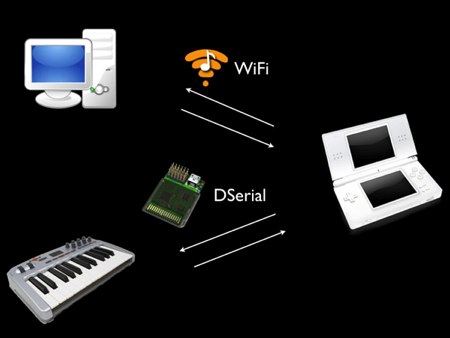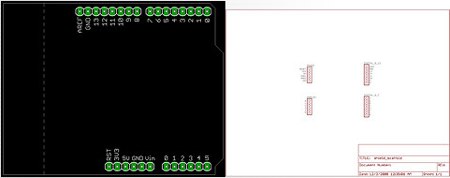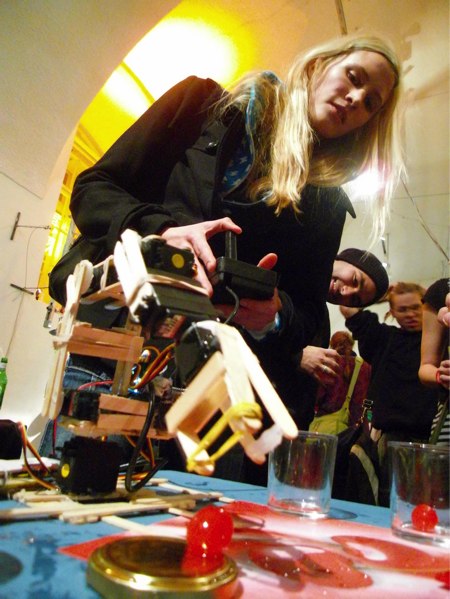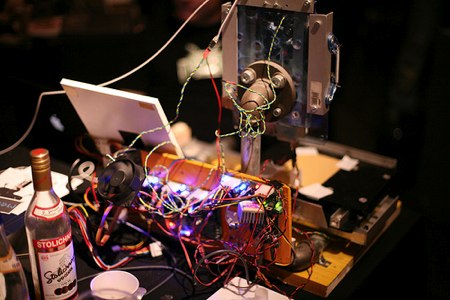Nintendo DS OSC support

OpenSound Control protocol is an emerging standard for communication between musical programs. It’s meant to replace MIDI. The DSMI, DS Music Interface, team has just added support for OSC. You can now use your DS as generic OSC music controller over WiFi. OSC has TCP/IP support built in, so there is no need to run a host sever to talk to DSMI like you did when they only supported MIDI. We’ve seen OSC used in other projects like the monome. It’s also the basis for the multitouch communication protocol TUIO.
[via CDM]

Netbook comparator

Our recent netbook post got a huge response. They are almost unanimously loved. A few dissenting opinions were present though. A few people mentioned that until this generation arrived, they were buying used subnotebooks for exactly the same reasons.
If you’re in the market for a new machine, Obsessable’s netbook comparator has all of the current models broken down by feature.

Arduino shield scaffold

[Garrett] from macetech has been prototyping shields for the Arduino development platform. Arduino’s have an inexplicable nonstandard spacing between two of the banks of output pins. This means that you can’t use regular perfboard with them. To make the design process quicker, [Garrett] has put together an Eagle file that just includes the male header pins. The file also has a line indicating the tall lower board components so you can avoid creating shorts.

Track the sun for home lighting.

Have a room in your house that really could benefit from some sunlight? Build a Suntrack to reflect light in as long as possible. The two axis motor set up is built from a couple of satellite dish positioning motors with the control electronics removed. The whole thing is controlled with a PIC 18f2520. Once calibrated, it will reflect the sun into your room, updating every twenty seconds. While this may not be the most efficient way of lighting a room, it is a cool way to do it if you absolutely must have sunlight. We can’t help but wonder if there would be a way of using a solar powered system to do this to save energy. Could this possibly be done using BEAM “head” circuit?
[via Hacked Gadgets]

LED projector

[PuffMag1cDrag0n] shows us how to make a fairly simple projected LED display. The projector is made from a 13×7 LED matrix and a couple fresnel lenses. The layout and construction is similar to the Lumenlab projector setup, only replacing all the lighting and LCD with an LED array. It communicates via serial port and is powered by a pic micro 16f648. We would love to see an RGB version of this. The directions are a bit rushed, but you should be able to get the gist. Just remember that you need some pretty powerful LEDs to throw a big image.

Roboexotica 2008

We couldn’t make Roboexotica in Vienna, Austria this year (check out last year’s coverage), so we asked [Bre Pettis] to act as our liaison.
Last night was the opening party of Roboexotica, the worldwide gathering of cocktail robots. It was a blast! Pictured above is Robovox, a 40 foot high robot that you can text message to and it will say what you text to it!

I was running my robot arms as a competition, armatron style, to get cherries into a shot glass.

The Reprap that Marius, Philipp, and the gang over at Metalab made last year that failed was revived and cranked out shot glasses all night!
Here are my photos. More photos tagged Roboexotica are coming in all the time, stay tuned!

Controller button marquee

[Ben Heck] posted an interesting one-off project he built many months ago. Video game developer Infinity Ward approached him to build a large display that indicated what buttons on a controller were being pressed. They were planning on using it during player testing by recording the board and the monitor at the same time. They could then compare the two to see if there was any disconnect between the players input and the onscreen action. Infinity Ward is the developer behind games like Call of Duty 4.
[Ben] piggy-backed the switch connections and added an external port. He used a pair of octal buffer ICs to replicate the signals and activate the LEDs. The whole board is powered by the same 3.3V line that’s used by accessories like the chat pad. The triggers have three LEDs each and are lit using a resistor ladder. [Ben] comments that since this is a newer Xbox 360 controller, the active-low button scheme makes it fairly easy to work with. There is a video of the board embedded below.

iPhone controlled dog treat dispenser
[Stephen Myers] has been toying around with some beta ioBridge hardware. He decided to build a remote control dog treat dispenser. ioBridge’s hardware is built specifically to make web enabling projects easy. The main controller board has four I/O channels that speak to addon modules. It has an ethernet port on the main board and an easy to configure website.
[Stephen] used a servo addon board for his project. The dispenser is built from a scrap CD spindle attached to a servo. He can issue commands from his iPhone, which shows live video of the kennel. He’ll be building several other automation projects based on this system.
[via TUAW]

Robot Strippers not too enticing

We really aren’t sure what the statement is here. This is one of the displays at the MuTate London Exhibition. There is tons of stuff to see there, from interactive displays to giant art-piece vehicles. This specific display seems to have garnered the most attention though. we can understand the megaphone headed flailing DJ, but what is with the CCTV camera heads?
[via Gizmodo]

Musical shirt from toy keyboard

[mikamika] has put together a great tutorial on how to build this musical shirt. The whole process is covered, from taking apart the toy keyboard to laying out the circuit and creating the fabric switches. He used the same method as [plusea] for the fabric buttons and conductive thread for most of the connections. It seems as though he has actually taken [plusea]’s wearable shirt project and added some polish. His looks good enough, he might even be able to make it through an airport.

You received this email because you are subscribed to the real_time feed for http://hackaday.com/feed/. To change your subscription settings, please log into RSSFWD.

